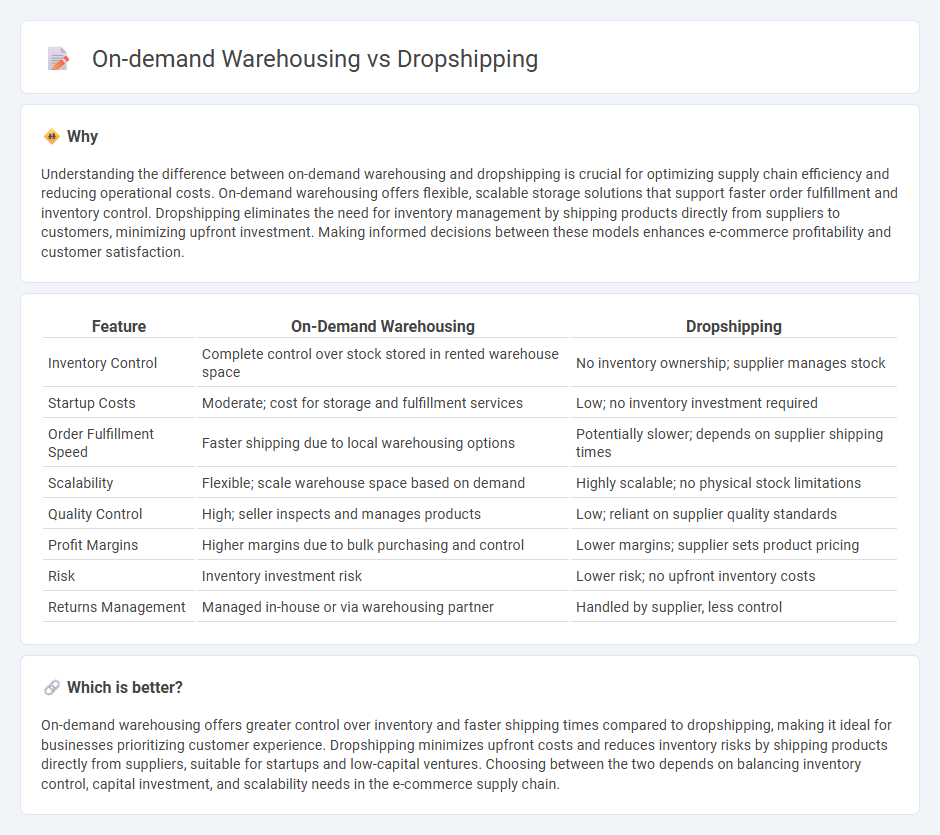
On-demand warehousing offers flexible, scalable storage solutions that reduce fixed costs and improve inventory management compared to traditional warehousing and dropshipping models. Dropshipping eliminates upfront inventory investment but often faces challenges with longer shipping times and supplier reliability. Explore these strategies to determine the best fit for optimizing your e-commerce supply chain.
Why it is important
Understanding the difference between on-demand warehousing and dropshipping is crucial for optimizing supply chain efficiency and reducing operational costs. On-demand warehousing offers flexible, scalable storage solutions that support faster order fulfillment and inventory control. Dropshipping eliminates the need for inventory management by shipping products directly from suppliers to customers, minimizing upfront investment. Making informed decisions between these models enhances e-commerce profitability and customer satisfaction.
Comparison Table
| Feature | On-Demand Warehousing | Dropshipping |
|---|---|---|
| Inventory Control | Complete control over stock stored in rented warehouse space | No inventory ownership; supplier manages stock |
| Startup Costs | Moderate; cost for storage and fulfillment services | Low; no inventory investment required |
| Order Fulfillment Speed | Faster shipping due to local warehousing options | Potentially slower; depends on supplier shipping times |
| Scalability | Flexible; scale warehouse space based on demand | Highly scalable; no physical stock limitations |
| Quality Control | High; seller inspects and manages products | Low; reliant on supplier quality standards |
| Profit Margins | Higher margins due to bulk purchasing and control | Lower margins; supplier sets product pricing |
| Risk | Inventory investment risk | Lower risk; no upfront inventory costs |
| Returns Management | Managed in-house or via warehousing partner | Handled by supplier, less control |
Which is better?
On-demand warehousing offers greater control over inventory and faster shipping times compared to dropshipping, making it ideal for businesses prioritizing customer experience. Dropshipping minimizes upfront costs and reduces inventory risks by shipping products directly from suppliers, suitable for startups and low-capital ventures. Choosing between the two depends on balancing inventory control, capital investment, and scalability needs in the e-commerce supply chain.
Connection
On-demand warehousing and dropshipping are connected through their ability to streamline inventory management and order fulfillment for e-commerce businesses. On-demand warehousing provides flexible storage solutions that support dropshipping by enabling faster shipping times and reduced logistics costs. This integration enhances supply chain efficiency, allowing retailers to scale operations without maintaining large inventory holdings.
Key Terms
Inventory Management
Dropshipping eliminates the need for inventory management by allowing retailers to transfer customer orders directly to suppliers, minimizing storage costs and risks. On-demand warehousing offers flexible inventory storage solutions that optimize stock control and enable rapid fulfillment without long-term commitments. Explore more about how each approach revolutionizes inventory management strategies.
Fulfillment
Dropshipping fulfillment relies on suppliers to store and ship products directly to customers, minimizing inventory management for retailers but often resulting in longer delivery times and less control over packaging. On-demand warehousing offers flexible storage and quicker fulfillment by allowing businesses to store inventory closer to customers, enhancing delivery speed and customization options. Explore the advantages of each method to optimize your supply chain efficiency and customer satisfaction.
Supply Chain
Dropshipping eliminates inventory holding by directly shipping orders from suppliers to customers, reducing warehousing costs and streamlining supply chain operations. On-demand warehousing offers flexible storage solutions, optimizing inventory management and enabling faster order fulfillment through strategically located warehouses. Explore how each model impacts supply chain efficiency and business scalability for informed operational decisions.
Source and External Links
What Is Dropshipping and How Does It Work? (2025) - Dropshipping is a business model where you sell products online without holding inventory, as the supplier ships items directly to your customers after they place an order with your store.
How to Start a Dropshipping Business in 7 Easy Steps - In dropshipping, you forward customer orders to a supplier who handles storage and shipping, allowing you to earn a profit margin without ever handling the physical products.
What Is Dropshipping and How Does It Work? - As a dropshipper, your main responsibilities are setting up an online store, marketing products, and managing customer relations, while all fulfillment and logistics are handled by your suppliers.
 dowidth.com
dowidth.com